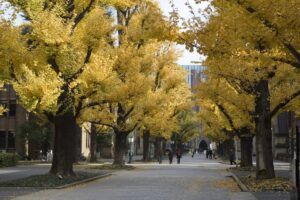
Soprattutto, la chiave del successo è iniziare il processo di iscrizione all'università il prima possibile. Per gli studenti internazionali che intendono studiare all'estero, la strada per l'ammissione prevede molti passaggi. Quando ho fatto domanda per un programma di master negli Stati Uniti, anche se il caso è stato relativamente veloce, ci sono voluti circa 10 mesi dall'inizio della preparazione alla ricezione della lettera di accettazione. Poi c'è stata la procedura di rilascio del visto e, per coloro che necessitano di un sostegno finanziario, sono stati necessari anche accordi bancari. Lo stesso vale per la domanda di ammissione ai corsi di laurea presso le università giapponesi. In questo post, tratteremo i requisiti principali e la tipica tempistica di candidatura per studiare in Giappone, in particolare per gli studenti universitari.
1. 5 Requisiti fondamentali per l'ammissione
【1】Fondo accademico
È necessario aver completato almeno 12 anni di istruzione formale nel proprio Paese, equivalenti al diploma di scuola superiore giapponese. Se il vostro Paese ha un sistema di 11 anni (ad esempio, Russia, Indonesia), alcune università potrebbero richiedere un programma preparatorio aggiuntivo o uno screening per confermare l'idoneità.
Conoscenza della lingua giapponese - JLPT N2 o punteggio EJU giapponese
Se intendete studiare in un programma di insegnamento in giapponese, dovrete avere una forte padronanza della lingua. La maggior parte delle università richiede un livello JLPT N2 o superiore, oppure un punteggio elevato (ad esempio, 200+ su 400) nella sezione giapponese dell'EJU (Examination for Japanese University Admission for International Students). Alcune scuole possono accettare entrambi, ma altre possono specificare l'uno o l'altro, quindi assicuratevi di controllare i loro requisiti.
Capacità accademiche - Esami EJU o Internazionali
La maggior parte delle università giapponesi richiede ai candidati di dimostrare le proprie capacità accademiche attraverso esami standardizzati. Uno degli esami più comunemente utilizzati è l'EJU (Examination for Japanese University Admission for International Students). Le materie richieste dipendono dalla specializzazione che lo studente intende conseguire. Ad esempio, gli studenti che si iscrivono a corsi di studi umanistici o di scienze sociali sono tenuti a frequentare la lingua giapponese, gli studi generali e la matematica (corso 1). Gli studenti che si iscrivono a corsi di laurea in scienze o ingegneria devono generalmente seguire la lingua giapponese, due materie scientifiche (come fisica, chimica o biologia) e la matematica (corso 2). In alternativa, alcune università - soprattutto quelle che offrono programmi basati sull'inglese - accettano test standardizzati riconosciuti a livello internazionale, come il SAT, l'ACT, l'International Baccalaureate (IB) o i risultati dell'A-Level al posto dell'EJU.
Screening specifico per l'università: saggi, interviste e altro ancora.
Oltre ai punteggi dei test accademici, molte università giapponesi richiedono ai candidati di superare ulteriori fasi di selezione. Queste includono spesso la presentazione di una dichiarazione di intenti che spieghi chiaramente la motivazione e gli obiettivi accademici dello studente. Anche un colloquio, che può essere condotto online, fa comunemente parte del processo di selezione. Poiché i requisiti possono variare in modo significativo da un'università all'altra, è essenziale documentarsi in anticipo sulle linee guida di ammissione di ciascuna istituzione. Essere ben informati vi aiuterà a non perdere condizioni o scadenze importanti.
Preparazione finanziaria o borse di studio
Studiare in Giappone costa in genere tra 1.500.000 e 2.500.000 ¥ all'anno, comprese le tasse scolastiche e le spese di soggiorno. Se avete bisogno di assistenza finanziaria, sono disponibili diverse borse di studio. Queste includono Borsa di studio MEXT, che è interamente finanziato dal governo giapponese; JASSOche fornisce uno stipendio mensile agli studenti idonei; e varie borse di studio specifiche per l'università o premi da fondazioni private.
2. Tipico Tempistica per l'iscrizione alle università giapponesi
【1】Circa 1 anno prima dell'ammissione (aprile-giugno)
Questo è il momento di iniziare a chiarire il vostro scopo di studiare in Giappone e di decidere il vostro campo di interesse. Dovreste anche iniziare a ricercare il livello di conoscenza della lingua e le risorse finanziarie necessarie. Controllate attentamente le linee guida di ammissione di ogni università per verificare se soddisfate i requisiti accademici e linguistici. Iniziate a confrontare le università e a restringere la vostra lista di scuole di destinazione. Se intendete fare domanda per la borsa di studio MEXT attraverso la raccomandazione dell'ambasciata, le candidature iniziano in genere in questo periodo: è quindi essenziale prepararsi per tempo e raccogliere i documenti.
【2】10 mesi prima dell'ammissione (luglio-agosto)
Pianificate i test linguistici necessari, come il JLPT o l'EJU, e confermate le date dei test. Se avete sostenuto la prima prova dell'EJU, i risultati dovrebbero arrivare a luglio. Completate l'elenco delle università di destinazione e create un calendario per le scadenze delle domande e degli esami di ammissione. Iniziate a redigere la vostra dichiarazione di intenti. È anche un buon momento per contattare i vostri consiglieri e spiegare le tempistiche per l'invio di una lettera di raccomandazione.
【3】7-8 mesi prima dell'ammissione (settembre-ottobre)
È il momento di preparare tutti i documenti necessari per la candidatura. Non appena saranno disponibili i moduli di domanda, iniziate a compilarli e a rivedere attentamente il materiale scritto. Richiedete le vostre trascrizioni ufficiali e il certificato di diploma (previsto) alla vostra scuola attuale, poiché potrebbero richiedere del tempo per essere rilasciati. Chiedete ufficialmente al vostro raccomandante di scrivere la lettera e fornitegli il formato richiesto, se l'università ne ha uno. Se dovete ancora raggiungere il livello di giapponese richiesto, iscrivetevi al JLPT di dicembre (la seconda prova dell'anno). Inoltre, iniziate a prepararvi per la seconda prova dell'EJU a novembre, studiando le materie necessarie come il giapponese, le scienze, la matematica o gli studi generali, a seconda del vostro settore.
【4】5-6 mesi prima dell'ammissione (novembre-dicembre)
In questo periodo, la maggior parte delle università inizia ad accettare le domande degli studenti internazionali. Inviate i documenti con attenzione: i sistemi online richiedono un'immissione accurata e le domande inviate per posta devono arrivare entro la data di scadenza, non devono fare fede il timbro postale. Se possibile, inviatele in anticipo per evitare problemi dell'ultimo minuto. La seconda prova dell'EJU si svolge a metà novembre. Dopo aver sostenuto il test, controllate i punteggi stimati e preparatevi a inviare i risultati ufficiali alle università una volta rilasciati a fine dicembre. Se prevedete di sostenere un colloquio scritto o online nell'ambito del processo di selezione, questo è il momento di prepararsi ed esercitarsi.
【5】3-4 mesi prima dell'ammissione (gennaio-febbraio)
In genere, gli esami di ammissione e i colloqui si tengono in questo periodo. Se vi recate in Giappone per gli esami di persona, dovrete procurarvi un visto a breve termine e organizzare il viaggio. Se i colloqui si svolgono online, assicuratevi che la vostra connessione a internet e il vostro ambiente siano affidabili. Alcune università che si affidano esclusivamente allo screening dei documenti potrebbero iniziare ad annunciare i risultati in questo periodo. Una volta accettati, dovrete confermare l'iscrizione e pagare la tassa di ammissione entro la scadenza indicata. Anche i candidati alle borse di studio MEXT tramite raccomandazione dell'ambasciata riceveranno i risultati finali in questo periodo. Se non siete stati selezionati, tenetevi pronti a continuare con le vostre domande autofinanziate.
【6】2 Mesi prima dell'ammissione (febbraio)
A questo punto, l'università prescelta inizierà il processo di richiesta del Certificato di Idoneità (COE), necessario per ottenere il visto per studenti. Seguite attentamente le istruzioni dell'università e fornite tutti i documenti necessari, come fototessere, prove finanziarie e altri moduli. Probabilmente riceverete anche la lettera ufficiale di ammissione, che dovrete conservare con cura: potrebbe essere necessaria per le procedure di immigrazione o per la richiesta di borse di studio. Se avete fatto domanda per borse di studio universitarie o private, questo è il momento in cui potete aspettarvi di ricevere i risultati. Se siete stati selezionati, seguite le istruzioni per completare le procedure o i documenti richiesti. Dovete anche decidere dove vivrete in Giappone. Se avete fatto domanda per un dormitorio studentesco, di solito il risultato viene comunicato in questo periodo. Se non siete stati accettati o se preferite un alloggio privato, è il momento di cercare un appartamento con l'aiuto dell'ufficio di supporto dell'università o di un'agenzia immobiliare. Potreste anche prendere in considerazione la possibilità di prenotare un alloggio temporaneo (ad esempio, un hotel o un affitto a breve termine) per il vostro arrivo.
【7】1 Mese prima dell'ammissione (marzo)
Una volta rilasciato il COE, recatevi presso l'ambasciata o il consolato giapponese di zona per fare domanda per il vostro visto per studenti. L'elaborazione del visto richiede in genere 1-2 settimane, quindi non aspettate troppo. Dopo il rilascio del visto, verificare che sia correttamente attaccato al passaporto. Ora è il momento di prenotare il vostro volo per il Giappone. Quando pianificate il viaggio, tenete conto della data del programma di orientamento della vostra università e della data di trasloco nel dormitorio. Assicuratevi di preparare gli oggetti essenziali per la partenza: contanti o una carta di credito internazionale, documenti importanti (lettera di ammissione, notifica della borsa di studio, COE, libretto delle vaccinazioni, ecc.) e oggetti personali come medicinali o un adattatore di corrente. È buona norma organizzare i documenti in una cartella e portarli nel bagaglio a mano per evitare problemi all'immigrazione.
【8】Arrivo in Giappone (aprile)
Ce l'avete fatta! Una volta arrivati in Giappone, dovrete passare l'immigrazione e all'aeroporto vi verrà rilasciata la carta di soggiorno. Subito dopo, dovrete recarvi all'ufficio comunale per registrare il vostro indirizzo e iscrivervi al sistema di assicurazione sanitaria nazionale. La vostra università terrà una sessione di orientamento per aiutarvi a iniziare la vita studentesca in Giappone. Le lezioni inizieranno poco dopo, quindi prendetevi il tempo necessario per ambientarvi e prepararvi agli studi.


